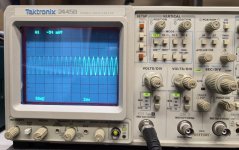Working on the last output board. I am not reading anything between TP101 and TP102. I moved the test leads directly to the emitter leads and still nothing. However, when I turn R109, I do notice the current on each rail going up. So, I'm thinking the bias circuit is working, something else is at play. I tested the bases of the output transistors and get -176mV and 133mV with +-32V rails. I am sure it has the wrong LED's in it, they light up but dimly and measure 1.6V across them. The recommended LED's measure a little over 1.7V. Any ideas?
D111 and Q101 were both toast, replaced them now have the correct readings on TP105 and TP106. I am still getting no reading across TP1 and TP2 and the reading does not change when turning R11, however I do see an increase in current draw on each rail. Any ideas?
Measuring all output, I measure:
NPN's
B 126mV
C 31.9V
E-10.2mV
PNP's
B -177mV
C -32V
E -10.2mV
The emitter readings seem funny to me. What would cause that?
NPN's
B 126mV
C 31.9V
E-10.2mV
PNP's
B -177mV
C -32V
E -10.2mV
The emitter readings seem funny to me. What would cause that?
Figured out the emitter readings are normal. I'm the issue. Didn't turn R11 far enough to start moving the reading across TP101 and TP102. I saw the amperage going up and just didin't turn it far enough. Three working IPS boards and two working EF3-3 with one EF3-3 board needing a replacement transistor and a diode. Thank you everyone for the tips.
Thanks. Will do.
An FYI for other builders. I did find an issue with one board. When adjusting bias when I got close to 44mV across TP101 and TP102, it would suddenly jump up to around 68mV, then down, then up, etc. I found it was caused by R109 being at the end of its adjustment range. R108 was specified as 560R in the BOM, I'll be changing that board to 470R and installing a new R109 pot. That will move the adjustment more towards the middle of R109. This was also the board that I had to turn so far to get any reading across TP101 and TP102.
Rick, what version boards do you have? Will this affect EF3-4 (V. 4.0), 3rd group buy boards?
Version 4.0 EF3-3 and Version 3.8 IPS. Build your boards using the correct BOM for your version. I think this is a one off and you have not heard any issues like this before now. Just giving a heads up of something odd that I ran into. More then likely the predrivers and/or the drivers that are installed are way out on the fringe with beta specs.
"More then likely the predrivers and/or the drivers that are installed are way out on the fringe with beta specs." Can you say more about this: "way out on the fringe. with beta specs." Not sure what the issue is.
Thanks
Thanks
I'm no expert, maybe someone else could comment, but some combination of transistors, resistors, capacitors, is making this board bias at a little different required resistance than the other boards. Since the resistors and capactitors are very good quality, I'm suspecting something with the transistors is not in the bell part of the curve. That does not mean they will not work just as good as any other transistor, they just need a different resistance to get the bias right.
Transistors can be highly variable in their characteristics. Some part numbers are better that way than others. Parallel output transistors should always have their beta matched.
If the beta and/or E-B drops are off-normal, you may have to adjust part values in the bias circuit. You do not want the bias control to have so much range that adjustment is difficult. Personally, I test each device before installation and units too high or too low in beta are not used. A transistor with higher beta than the normal range is not better, it is abnormal. Use those abnormal devices in non-critical circuits that don't stress them.
If the beta and/or E-B drops are off-normal, you may have to adjust part values in the bias circuit. You do not want the bias control to have so much range that adjustment is difficult. Personally, I test each device before installation and units too high or too low in beta are not used. A transistor with higher beta than the normal range is not better, it is abnormal. Use those abnormal devices in non-critical circuits that don't stress them.
I've also noticed the team has adjusted R108 up in value over the different versions. I'm suspecting to help keep from overbiasing the board on startup.
- Home
- Amplifiers
- Solid State
- DIY Class A/B Amp The "Wolverine" build thread
